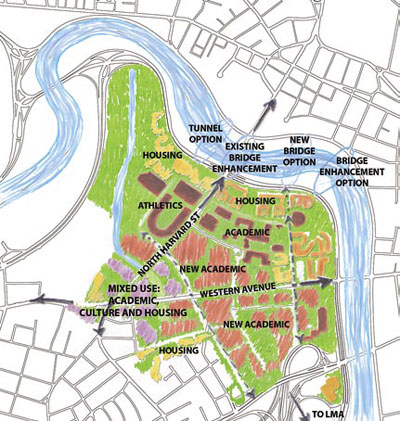Calling “effective transportation” the “most critical” of the issues Harvard faces as it plans for expansion into Allston, consultants Cooper, Roberston & Partners, in an “interim report” undertaken within the context of the priorities outlined by President Lawrence H. Summers in 2003, have analyzed how Harvard’s land there could be used to accommodate the University’s phased growth over the next 10 to 50 years. The report, released June 2, identifies possible sites for the graduate schools of education and public health, for two 500,000-square-foot science buildings, and for four new undergraduate Houses, in addition to outlining several options that would greatly improve connections across the Charles River.
 |
| Development options for the Allston campus |
| Graphic courtesy of Cooper, Robertson & Partners, from the Interim Report: Physical Framework Concepts for Allston |
The report suggests enhancements to existing bridges and roadways, and even the construction of a new bridge or tunnel, as ways to improve cross-river transportation. Depressing parts of Soldiers Field Road, which runs along the Allston side of the Charles, would facilitate community access to the river and make the crossing more pedestrian-friendly. Eliminating parking on North Harvard Street, where it runs alongside the Stadium, paired with improvements to the Larz Anderson Bridge, would allow four travel lanes to better accommodate pedestrians, cyclists, public transit, and private vehicles, the report says. Other options include a tunnel for shuttles that would run from the existing MBTA bus station under Harvard Square to Allston, or a shuttle and pedestrian bridge that would begin between the two halls of Winthrop House. All would require approval by and partnerships with a variety of community, city, and state agencies.
In an effort to provide a long-term framework that can serve as a basis for discussion, and at the same time allow some projects to be done within the next decade, the report suggests several possible locations for the science laboratories, the academic buildings of the professional schools, and the new undergraduate Houses. All are sited on land that Harvard owns now and that is unencumbered by leases or rights of way.
Many of these sites already have Harvard buildings on them. In one proposal, new Houses would displace current College athletic facilities such as Blodgett Pool and the Palmer-Dixon Courts, while academic buildings would rise on Ohiri Field and other sites south of the Business School. New locations for the displaced buildings and uses are not identified. Planners expect public discussion of the report, available on line at www.allston.harvard.edu, to take place over the next few months.





